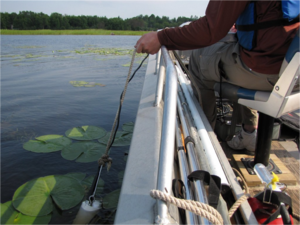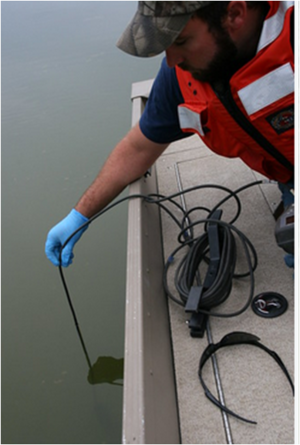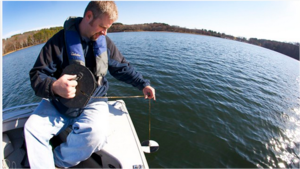
Recommendations and guidance for utilizing lake monitoring to meet TMDL permit requirements
The primary reasons for a permittee to perform monitoring of receiving waters are to (a) evaluate the impact of TMDL implementation strategies enacted throughout the watershed, and (b) evaluate impairment status to determine if the impaired waterbody can be removed (i.e., delisted) from the 303(d) Impaired Waters List. The following subsections outline the basics of developing a monitoring program to meet goals established within the Guidance Manual for Assessing Quality of Minnesota Surface Waters for Determination of Impairment: 305(b) Report and 303(d) List (MPCA, 2018a), and developing a monitoring protocol standard operating procedure (SOP). Specifically, the Establishing a Monitoring Program section provides guidance on when, where, and what to sample, while the Establishing a Monitoring Protocol section provides guidance on how to sample (i.e., sampling SOP).
Contents
Establishing a Monitoring Program
Before developing or implementing a lake monitoring program, the applicable TMDL(s) should be reviewed to determine (a) if an ongoing water quality monitoring program exists or will be implemented and (b) what organization(s) are responsible for water quality monitoring (e.g., individual permitteess, the applicable Watershed District or Watershed Management Organization (WMO), etc.). Review of ongoing and planned water quality monitoring programs can help a permittee optimize sampling procedures to supplement ongoing monitoring efforts and help identify potential partnering opportunities with other organizations (e.g., WDs, WMOs, Citizen-Assisted Monitoring Program (CAMP), Soil and Water Conservation Districts (SWCDs), Metropolitan Council, etc.). To encourage statewide water quality monitoring efforts, the MPCA offers Surface Water Assessment Grants (SWAG) to eligible partners, including MS4s. More information on SWAG requirements and grant application can be found on the MPCA’s Surface Water Assessment Grants webpage.
In addition to review of planned or ongoing monitoring programs, the applicable TMDL(s) should be reviewed to determine the specific water quality standard(s) that apply to the impaired waterbody. Water quality standards applicable to the impaired waterbody are specific to the pollutant (e.g., chloride), the water body type (e.g., lake), and the water use classification (e.g., Class 2A).
Monitoring requirements: lakes
The following subsections outline specific lake monitoring program requirements related to each of the four (4) pollutants discussed on this page: total suspended solids (TSS), total phosphorus (TP), bacteria, and chloride.
Total suspended solids (TSS)
As of 2018 Minnesota Impaired Waters List (MPCA, 2018b) there are no lakes listed as impaired for TSS. For more information regarding establishing a TSS monitoring program for streams, link here.
Eutrophication standard: lakes (TP, chlorophyll-a, and Secchi disk transparency)
Lake eutrophication water quality standards established in the Minnesota Rule, Chapter 7050 (MINN. R. 7050, 2018) require paired observations of TP, chlorophyll-a, and Secchi disk transparency during the summer period (June 1 through September 30) of the monitoring year. From Part 7050.0222, Subp. 2a:
Eutrophication standards for lakes and reservoirs are compared to summer-average data. Exceedance of the total phosphorus and either the chlorophyll-a or Secchi disk transparency standard is required to indicate a polluted condition.
The numeric standards for TP, chlorophyll-a, and Secchi disk transparency vary by use classification (e.g., Class 2B), ecoregion (e.g., North Central Hardwood Forests), and by lake classification (e.g., trout lake, shallow lake, etc.). The applicable water quality standards for the impaired waterbody are outlined in the applicable TMDL report. Based on Minnesota lake eutrophication standards and specific impairment assessment and delisting requirements for lake eutrophication, the following list outlines specific recommendations to develop a lake eutrophication monitoring program. Specific monitoring protocol recommendations are discussed here.
Lake Eutrophication Monitoring Program Recommendations
- Number of samples per year:
- Minimum: eight (8) paired samples of TP, chlorophyll-a, and Secchi disk over a minimum of a 2 year period within the most recent 10 years.
- Recommended: four (4) or more paired samples of TP, chlorophyll-a, and Secchi disk transparency collected between June 1 and September 30 per year on an ongoing basis to continually monitor and evaluate lake eutrophication. Sampling dates should be selected and fixed before the monitoring season to remove sampling bias in selected monitoring dates. Monitoring should, to the extent possible, be collected at equal intervals throughout the period of June 1 to September 30 (i.e., sampling should capture seasonal changes in water quality).
- Seasonal monitoring requirements: Samples must be collected between June 1 and September 30 of the sampling year.
- Sampling location(s): Selected sampling locations should be consistent with sampling locations used to originally define impairment. Sampling locations used to define impairment may be outlined within the applicable TMDL(s). If not, contact MPCA to determine sampling location used to define impairment.
- Sampling protocol (i.e., sample collection guidance): link here.
Bacteria (E. coli)
As of the 2018 Minnesota Impaired Waters List (MPCA, 2018b) there are no lakes listed as impaired for Escherichia coli (E. coli). For more information regarding establishing an E. coli monitoring program for streams, link here.
Chloride
Chloride water quality standards within Minnesota Rule, Chapter 7050 (MINN. R. 7050, 2018) are consistent for all Minnesota waters (i.e., all use classifications). Specifically, Minnesota Rules define a chronic toxicity-based chloride water quality standard of 230 mg/L (i.e., chronic standard), and an acute toxicity standard of 860 mg/L (i.e., maximum standard). Specific data requirements for evaluation of impairment condition for both the chronic and maximum chloride water quality standard established in the Guidance Manual for Assessing the Quality of Minnesota Surface Waters for Determination of Impairment: 305(b) Report and 303(d) List (MPAC, 2014) are outlined below.
- Chronic standard (230 mg/L):
- Exceedances of chronic standards for toxic pollutants are evaluated over a consecutive three year period.
- Two or more exceedances of the chronic standard in three years is considered an impairment.
- Chronic water quality standards are defined as a four (4) day average concentration. If concentrations in the waterbody are relatively stable, a single sample concentration value may be used to define the 4-day average. When concentrations are more variable, multiple samples or time-weighted composite samples are necessary to calculate an accurate average concentration.
- Maximum standard (860 mg/L):
- Exceedances of the maximum standards for toxic pollutants are evaluated over a consecutive three year period.
- One (1) exceedance of the maximum standard is considered an impairment.
The MPCA has published several Statewide Chloride Resources, including the Draft Statewide Chloride Management Plan (MPCA, 2019) and specific protocols related to stream and lake chloride monitoring.
Based on review of chloride standards, statewide guidance documents, and specific impairment assessment and delisting requirements for chloride impairment, the following list outlines specific recommendations for developing a lake chloride monitoring program. Specific monitoring protocol recommendations are discussed here.
Chloride Monitoring Program Recommendations
- Number of samples per year:
- Minimum: five (5) samples over any 3-year interval in the past 10 years.
- Recommended: five (5) samples per year for a 3-year interval. If chloride concentrations show high daily-variability (e.g., if daily concentrations vary by more than 30 mg/L), 4-day average sampling is required (i.e., five (5) separate 4-day average chloride concentrations should be used to evaluate chronic impairment).
- Depth monitoring recommendations:
- Recommended: for lakes more than 2 meters deep, samples should be collected at depths along the water column as described below because chloride concentration typically increases with depth. If 4-day averages are used, samples collected at each depth should be grouped and averaged together, rather than averaging all samples collected throughout the water column:
- Shallow: 0-2 meters;
- Deep: deepest 2 meters of the water column; and
- Mid-depth: midway between depths defined as “shallow” and “deep”.
- Recommended: for lakes more than 2 meters deep, samples should be collected at depths along the water column as described below because chloride concentration typically increases with depth. If 4-day averages are used, samples collected at each depth should be grouped and averaged together, rather than averaging all samples collected throughout the water column:
- Seasonal / critical period monitoring recommendations:
- Recommended: chloride concentration can vary significantly throughout the season due to critical chloride loading periods (e.g., winter deicing efforts). For this reason, the TMDL should be reviewed to determine if a critical period was identified (i.e., a seasonal period of most-elevated chloride concentrations). The following list provides examples of periods of elevated chloride concentration related to land use:
- January through May for lakes in urban areas and locations near deicing practices.
- April through November for lakes downstream of waste water treatment plant (WWTP) discharge locations.
- April through November for lakes downstream of heavy agriculture, near tile drainage systems, and/or proximal to gravel roadways that receive dust management.
- Recommended: chloride concentration can vary significantly throughout the season due to critical chloride loading periods (e.g., winter deicing efforts). For this reason, the TMDL should be reviewed to determine if a critical period was identified (i.e., a seasonal period of most-elevated chloride concentrations). The following list provides examples of periods of elevated chloride concentration related to land use:
- Sampling location(s): Selected sampling locations should be consistent with sampling locations used to originally define impairment. Sampling locations used to define impairment may be outlined within the applicable TMDL(s). If not, contact MPCA to determine sampling location used to define impairment.
- Miscellaneous recommendations: conduct paired conductivity (i.e., specific conductance) measurements during chloride monitoring. In some cases, a waterbody-specific chloride-conductivity relationship can be established. In these cases, conductivity can serve as a surrogate for chloride (as monitoring conductance is faster and cheaper than monitoring chloride directly). Review the TMDL report to determine if a waterbody-specific chloride-conductivity relationship has been established
- Sampling protocol (i.e., sample collection guidance): link here
Establishing a Monitoring Protocol
The MPCA has specific requirements and protocols related to water quality data collection, laboratory processing of water quality samples, data processing of laboratory results, and final submittal of water quality data to the MPCA for review. Specifically, the MPCA uses a data processing system called EQuIS (Environmental Quality Information System) to store and process water quality data collected from over 17,000 sampling locations across the state, and requires that data be collected and processed in a manner which is compatible with EQuIS.
There are many publicly available Quality Assurance Project Plan (QAPP) and monitoring Standard Operating Procedure (SOP) documents which can be used as a framework for developing a monitoring protocol. The following subsections provide an overview of EQuIS requirements and a summary of lake and stream monitoring QAPP and SOP documents.
EQuIS
The MPCA has developed extensive guidance related to establishing EQuIS projects, and developed tools and guidance to assist monitoring and laboratory staff to process data in an EQuIS-compatible format. The following steps provide a basic overview of the EQuIS data collection and submittal process: establishing an EQuIS project, processing collected water quality data, and submitting collected data to the MPCA for review. Collecting, processing, and submitting EQuIS data requires contact and coordination with an MPCA EQuIS team member.
- Coordinate with an MPCA EQuIS team member and establish an EQuIS project (i.e., submit the EQuIS Project Establishment Form).
- Submit a location establishment form.
- Collect water quality data and submit to a State-certified laboratory.
- Procedures to collect water quality samples and submit to a certified laboratory, including pre- and post-monitoring protocols, quality assurance and quality control ( QA/QC), and guidance regarding chain of custody (COC) preparation and documentation are discussed below.
- The MPCA EQuIS team member can be contacted regarding State-certified laboratories.
- Submit EQuIS formatted data to the MPCA for review.
- The EQuIS Data Gathering Engine (EDGE) can be used to generate EQuIS formatted data during field data collection.
- The Lab_MN lab data storage spreadsheet can be used by certified labs to generate EQuIS formatted data of laboratory results.
- If not using EDGE or Lab_MN, data can be manually formatted into the Surface Water Data Template.
Monitoring Quality Assurance Program Plan (QAPP)
The primary objective of a QAPP is to define the data quality assurance (QA) goals and procedures applicable to a monitoring program (MCES, 2003). A lake or stream monitoring QAPP must also provide an overview of program design (e.g., program organization, responsibilities, monitoring parameters, sampling locations, etc.), and must define sampling methods (e.g., sampling locations and monitored variables), analytical procedures, QA procedures, and data review protocols.
For this reason, a QAPP document may also contains monitoring SOP(s), defining sampling procedures, field analysis, laboratory analysis, and data review and QAQC measures.
The following subsections provide a summary of monitoring QAPP documents which can be used as templates for developing a lake or stream monitoring QAPP.
MCES Stream Monitoring QAPP
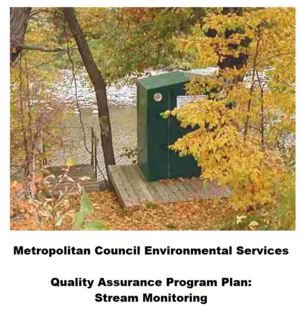
The MCES Quality Assurance Program Plan: Stream Monitoring (MCES, 2003; updated 2011) is a QAPP for the MCES’s Nonpoint Source Pollution Monitoring Program and Watershed Outlet Monitoring Program (WOMP). The QAPP defines goals, objectives, program organization, responsible parties, specific sampling procedures and protocols (e.g. monitoring SOPs, QA procedures, laboratory analytical procedures, etc.), and the monitoring locations, monitored variables, and monitoring frequency for both stream monitoring programs. Specifically, the QAPP is organized into the following sections:
- Introduction: defines the background and purpose of the QAPP, as well as the relationship of the QAPP to other guidance documents (specifically, the monitoring SOPs included as appendices).
- Program Organization and Responsibility: defines the organization of the QAPP, responsible parties, and defines roles and responsibilities for positions and individual staff members.
- Monitoring Program Description: defines the study area, specific monitoring locations, monitored variables (e.g., Total Phosphorus, CBOD 5-day, etc.), and monitoring frequency.
- Quality Assurance Objectives: defines QA objectives related to precision, accuracy, representativeness, completeness, comparability, and analytical sensitivity.
- Sampling Methods: defines procedures and protocols for two forms of sampling: instantaneous grab sampling and flow-weighted composite sampling. Provides and overview of sampling procedures, field equipment, and bottle preparation, etc. and refers reader to the field sampling SOPs included in the QAPP appendices.
- Field and Sample Custody Documentation: defines the field and sample documentation requirements for the MCES stream monitoring programs. Field documentation (e.g., field conditions, time, weather conditions, deviation from written procedures, standardized field documentation sheets) and laboratory chain-of-custody are critical for interpreting results and identifying erroneous samples (e.g., mislabeled samples).
- Field Measurement Procedures: defines field monitoring equipment (e.g., specific models of in situ monitoring equipment), monitoring station layout, maintenance, and operations, and a description of all monitoring parameters. More details related to field procedures are included in the monitoring SOPs included in the QAPP appendices.
- Laboratory Analytical Procedures: defines the laboratory analytical method for each monitored variable and identifies the State-certified laboratory used for sample processing and analysis. Additional information relate to laboratory procedures, processes, and QA program are included in the laboratory QA manual included in the QAPP appendices.
- Quality Assurance Procedures: defines QA procedures relate to data review and validation, QA audits and reporting, and corrective action strategies.
- Data Reporting: defines reporting protocols related to automate electronic data reporting and annual assessment reporting.
The organization of the MCES Stream Monitoring QAPP can be used as template for the development of a stream or lake monitoring QAPP. In addition to defining the organization, goals, and QA procedures for the monitoring programs, the QAPP also includes sampling, field analysis, laboratory analysis, and data review SOPs as appendices to the document. The SOPs outline specific monitoring procedures to be followed in the field (e.g., equipment checklist, grab sample bottle and equipment cleaning, field duplicate collection and labeling, health and safety procedures, etc.). Monitoring SOPs are discussed in more detail below.
Other Monitoring QAPP Resources
The MPCA and United States Environmental Protection Agency (USEPA) have developed many guidance documents related to QA and the development of QAPPs. Specific QAPP guidance documents and QA tools are summarized below:
- MPCA Quality System: aggregated resources related to QA of environmental data. Includes many QAPP development documents and examples of completed QAPPs. Additionally, includes documents related to the development of SOPs, example SOPs (e.g., lake monitoring SOP), and State-certified laboratory guidance and reference documents.
- MPCA QA Project Plan Guidance: guidance document for developing MPCA Remediation Program QAPPs.
- EPA QAPP Development Tool: web-based QAPP development tool. The tool provides step-by-step guidance related to developing a surface water monitoring QAPP, and is partitioned into the following six (6) modules:
- Module 1 – guidance on preparing a QAPP.
- Module 2 – QAPP template.
- Module 3 – Model QAPP: provides and model example of a completed QAPP.
- Module 4 – references and links for technical and QA information to assist in developing a QAPP.
- Module 5 – standard operating procedures (SOPs): contains development guidance and example SOPs related to surface water monitoring.
- Module 6 – selecting an environmental laboratory: provides guidance related to selecting a State-certified laboratory for sample processing.
- EPA Requirements for QAPPs: defines EPA QAPP requirements.
Questions related to QAPP development, QA procedures, or the references listed above can be directed to any of the MPCA QA coordinators listed in the “Contacts” section of the MPCA Quality System webpage.
Monitoring Standard Operation Procedure (SOP)
As discussed above, a monitoring standard operating procedure (SOP) is a critical component of a complete monitoring QAPP. A monitoring SOP defines specific protocols related to field sample collection and laboratory analysis, and often also includes pre-field protocols (e.g., equipment and supply checklist, pre-field bottle preparation and labeling, etc.), post-sampling protocols (e.g., sample preparation and preservation, sample chain of custody, etc.) and other protocols not specifically related to monitoring and sample collection (e.g., boat and canoe preparation, health and safety, inclement weather protocols, etc.).
The following subsections provide a summary of monitoring SOP documents which can be used as templates for developing a lake or stream monitoring SOP. It is recommended that the documents discussed in this section be used in conjunction with specific monitoring guidance outlined in the applicable TMDL when developing a lake or stream monitoring SOP.
NOTE: See example case studies in which monitoring was used to help identify pollutant sources, evaluate the impact of implementation strategies, and ultimately delist a formerly-impaired water body.
MPCA Lake and Stream Water Quality Sampling SOPs
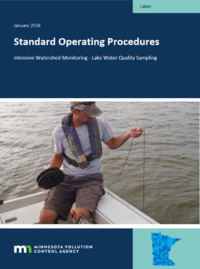
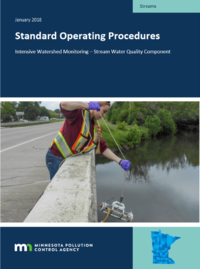
The Standard Operating Procedures: Intensive Watershed Monitoring – Lake Water Quality Sampling (MPCA, 2018c) and Standard Operation Procedures: Intensive Watershed Monitoring – Stream Water Quality Component (MPCA, 2018d) are SOPs created by the MPCA for local partners contracted through the MPCA’s Surface Water Assessment Grants Program. The SOP outlines sampling procedures applicable to all Minnesota lakes and streams, including pre-sampling requirements, equipment and supply checklists, on-site sampling procedures, QAQC procedures (e.g., field sample duplicates), post-sampling procedures, and a detailed discussion of health and safety protocols. In addition to pre- and post-sampling procedures, the SOP discusses bottle labeling and the chain of custody (COC) procedures for delivering samples to State-certified laboratories, and final data preparation and submittal to EQuIS.
Other Monitoring SOP Resources
The MPCA, USEPA, and MCES have developed many publically available guidance documents related to the development of surface water monitoring SOPs. Specific SOP documents which be used as templates to develop a surface water monitoring SOP are summarized below. It is recommended that the documents discussed in this section be used in conjunction with specific monitoring guidance outlined in the applicable TMDL when developing a lake or stream monitoring SOP:
- Chloride Monitoring Guidance for Lakes (MPCA, 2015a) and Chloride Monitoring Guidance for Streams and Stormsewers (MPCA, 2015b): these documents are similar in scope to the MPCA lake and stream monitoring SOPs (MPCA, 2018c; MPCA, 2018d), but include specific guidance related to monitoring chloride, including a detailed winter monitoring SOP. Winter monitoring guidance includes a detailed description of how to predict and monitor winter thaw and rain events, which often produce elevated chloride concentration in streams due to mobilization of deicing salts accumulated over winter deicing operations.
- MCES Quality Assurance Program Plan: Stream Monitoring (MCES, 2003; updated 2011): the stream monitoring QAPP contains sampling, field analysis, laboratory analysis, and data review SOPs as appendices.
- EPA QAPP Development Tool: Module 5 of the web-based tool contains development guidance and example SOPs related to surface water monitoring. SOP documents can requested from the EPA via the EPA contact listed in Module 5.
Questions related to SOP development can be directed to any of the MPCA QA coordinators listed in the “Contacts” section of the MPCA Quality System webpage.
Related pages
TMDL MS4 permit guidance
- Forms, guidance, and resources for completing the TMDL annual report form
- Guidance for meeting bacteria TMDL MS4 permit requirements
- Guidance for meeting dissolved oxygen or oxygen demand TMDL MS4 permit requirements
- Guidance for meeting temperature TMDL MS4 permit requirements
- Summary of TMDL requirements in stormwater permits
TMDL toolkit for MS4 permit compliance
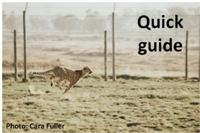
- Overview of models used to meet MS4 TMDL permit requirements
- Recommendations and guidance for utilizing P8 to meet TMDL permit requirements
- Recommendations and guidance for utilizing WINSLAMM to meet TMDL permit requirements
- Recommendations and guidance for utilizing the MIDS calculator to meet TMDL permit requirements
- Recommendations and guidance for utilizing the MPCA Simple Estimator to meet TMDL permit requirements
- Recommendations and guidance for utilizing monitoring to meet TMDL permit requirements
- Recommendations and guidance for utilizing lake monitoring to meet TMDL permit requirements
- Recommendations and guidance for utilizing stream monitoring to meet TMDL permit requirements
- Recommendations and guidance for utilizing major stormwater outfall monitoring to meet TMDL permit requirements
- Recommendations and guidance for utilizing stormwater best management practice monitoring to meet TMDL permit requirements
- Quick guides for using models to meet MS4 TMDL permit requirements
- Case studies for monitoring to meet TMDL permit requirements
TMDL guidance and general information
- Overview of TMDLs
- Addressing TMDL Requirements in MS4 General Permit Applications and Stormwater Pollution Prevention Program Documents
- List of approved TMDLs with MS4 Wasteload Allocations
- Technical guidance used by MPCA to develop guidelines for setting TMDL WLAs for regulated stormwater
- Case studies for regulated stormwater issues
- Guidance on what discharges should be included in the TMDL wasteload allocation for MS4 stormwater
- File:Guidance on What Discharges Should be Included in the TMDL Wasteload Allocation for MS4 Stormwater.docx - August 2010
- Construction activity by county
This page was last edited on 10 February 2023, at 13:47.
